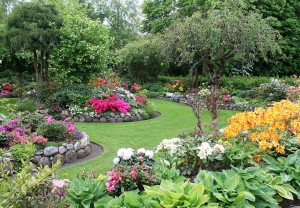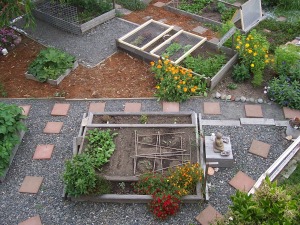A vegetable garden in your backyard can be a reliable source of fresh herbs and vegetables. It also gives you a chance to get out and get your hands dirty while you connect with nature. It is a great way to bring your family together and enjoy some outdoor fun as well.
Spring is right around the corner and it gives you a great opportunity to get out and get busy in your backyard garden. Even if you don’t have a lot of time, maintaining a garden only takes a few moments every day or a couple of hours over the weekend.
Growing your own vegetables in your garden does not cost much but it ensures fresh vegetables grown using organic methods and also allows your family to connect and have fun while you are doing it.
We are going to take you through the gardening process step by step so that you can start gardening in your spare time and benefit from fresh homegrown vegetables.
Planning a vegetable garden
 There are many different ways to design your backyard garden. You could do either a ground-level garden or raised bed garden.
There are many different ways to design your backyard garden. You could do either a ground-level garden or raised bed garden.
A raised bed garden has several advantages over traditional ground-level gardens. It’s a little easier on your back because you do not have to bend and kneel quite as much. Raised bed gardens can also be made very creative and aesthetically pleasing by using a variety of different building materials.
Whichever type of gardening you choose, the first thing you need is a plan and design for your garden.
As a part of your plan, you need to decide what type of crops you are going to grow in your garden. The type of crop you choose will depend on the size of your garden, the climate in your region, and the amount of time and effort you are willing to put into your project.
To choose your crop, find the first and last frost dates of your area and determine the best time to plant your crops and the length of your growing season. Some crops may take longer to grow than the growing season in your region.
You can grow several seasonal crops in the same space if you know the harvest dates of the crops and plan ahead. For example, you can grow fall carrots after spring peas.
Garden design
No matter where you live, whether in the city, in the suburbs, or in a rural area, you can always find a space to garden. Your design will vary depending on the available space and your surroundings.
Today, many people all around the world are growing fruits and vegetables indoors, on the roof tops, or in vertical gardens.
Starting small and simple is a great first step for your vegetable garden. The advantage of a small garden is that you don’t need heavy machinery to cultivate and most of the work can be done with manual labor.
You might need some light machinery and equipment if you plan on digging up a large area or building a structure from wood, stone, bricks, or similar materials.
Choose a suitable location
Make a sketch of the area that you are planning to use and draw a layout of the beds where you want them to be placed.
Choose a sunny location because most vegetables will need six to eight hours of sunlight during the day to grow their best.
Some leafy greens like lettuce or spinach thrive with less sunlight and can actually be burned by direct sun.
 Consider deciduous trees in your yard since as the seasons get warmer these trees will cast an increasingly larger shadow as their leaves grow lush.
Consider deciduous trees in your yard since as the seasons get warmer these trees will cast an increasingly larger shadow as their leaves grow lush.
To make your vegetable garden more aesthetic, place your beds alongside a fence to allow plants to climb or plant a raised bed garden made with bricks, wood, or stone; integrate your gardens into your landscaping.
Your beds could be any shape, consider rectangles, hexagons, or even rounded shapes to suit your area. However, avoid triangular beds because the narrow corners limit your growing space.
Choose the right size
As I mentioned earlier, starting small is the best way to start gardening and gradually increase the number of beds.
A 20 foot long by 20-foot wide square-shaped garden would allow you to grow a wide variety of crops including sweet summer crops, corn.
Start digging
Remove any grass from the area and loosen up your soil at least to a foot deep with a spade. Remove any rock and unwanted materials and add topsoil to it.
Mix with some organic fertilizers or make your own organic fertilizer from compost to improve the quality of your garden’s soil.
Layout
 Layout your crops in rows from north to south to prevent shading. Mark your garden rows with small stakes and strings. Follow spacing instructions that came with your plants.
Layout your crops in rows from north to south to prevent shading. Mark your garden rows with small stakes and strings. Follow spacing instructions that came with your plants.
Remember to water your plants regularly and remove all weeds.
Enjoy your Garden and watch your vegetable garden grow!
With a little care, you will be able to enjoy homegrown food right from your own garden. It’s also great as a hobby and a healthy habit for you that will encourage you and your family to eat healthily and connect with nature.
It will also bring your family together to enjoy the great outdoors and the magic and wonder of watching your garden grow!
If you already have a garden here’s a tip on renovating your garden on a budget on trimthatweed.com
If you’d like to learn more about sustainable agriculture or to learn about DIY sustainable feeding systems please join our EAT FREE Community, where you can make some money making the planet better! For more information, contact us at 303-495-3705 or Click here to book a meeting with us.
P.S: – We’d love to hear from you. Please leave a comment below or visit our Facebook Page and leave your comment there.
Source: Institute of Ecolonomics
Resources and related articles:
- Making a Vegetable Garden in Your Backyard
- National Gardening Association
- How To Make Your Own Organic Fertilizer Thorough Composting | Institute of Ecolonomics
- 5 Great Ideas for a Beautiful Vegetable Garden: Organic Gardening
- Raised Garden Beds – Build a Raised Garden! – Naturalyards.com
- How to Plan Your First Backyard Vegetable Garden | Institute of Ecolonomics
- Basics Of Growing Sweet Corn In Your Backyard Or Small Garden | Nourish The Planet



